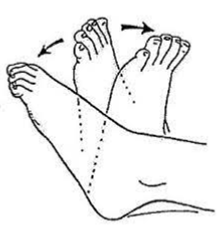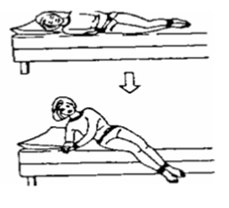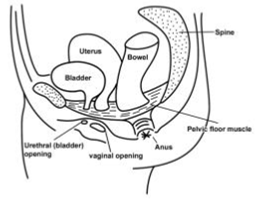Physiotherapy – Advice and exercises following a caesarean section
Advice and exercises following a caesarean section
These exercises and techniques are to help you get comfortable and recover after your caesarean section. A Caesarean section is a major operation, which involves an incision (cut) through the tummy muscles and womb. It may take up to 6-8 weeks to recover, for some women this may be longer, and it is important to allow yourself time to rest and recover.
It is common to experience pain / discomfort for the first few weeks when moving, getting in / out of bed or carrying out activities that cause strain on your tummy. Having anaesthetic can also cause you to feel more tired than usual and may cause sickness. However, it is important to start moving as soon as possible as it will help with your circulation, breathing and prevent your muscles and joints from getting too sore and stiff. You should be given pain relief after your caesarean to help you do this.
Advice following Caesarean Section surgery
Breathing Exercises: You may benefit from deep breathing exercises to reduce the risk of developing a chest infection while you are not up and walking about frequently.
Start by bending your knees up a little if you are lying flat. Take a deep breath in through your nose, hold the breath for 2 seconds before gently breathing out through your mouth. Repeat 3-4 times.
Coughing: You may experience pain or discomfort along the incision with coughing or sneezing. This can be reduced by supporting your stitches with your hands, a rolled-up towel or a small pillow, whilst leaning forwards.
Circulation Exercises: It is important to perform exercises to help with your blood flow and circulation early after your caesarean section, particularly while you are not as active as usual. This is to prevent a clot forming.
Bend your feet up and down from the ankle 15 times. This can be followed by circular movements on the ankle.
Both the breathing and circulation exercises should be done every hour.
Abdominal Exercises: This exercise can be started in the first few days once you feel ready and able. While supporting the lower part of your stomach with your hands, draw the muscles in towards your spine a small amount. Hold this for 3 seconds, and then relax. Repeat this 5 times, gradually increasing the time you are holding the exercise for.
Turning over in bed: Before moving, bend your knees up, keeping both feet flat on the bed and draw the lower part of your stomach in a small amount to ‘brace’ the movement.
Reach your arm over in the direction you are rolling, at the same time you roll your knees over. You may find it comfortable to support your stomach with your hand following your caesarean.

Illustration of circulation exercises
Getting in and out of bed: When you get yourself in and out of bed it is important to avoid the ‘sit-up’ movement. This is to allow your stomach muscles to recover.
Roll on to your side as explained above. Push yourself up into sitting using the hand of your upper arm against the mattress, whilst straightening your legs off the edge of the bed, allowing your feet to go down to the floor.
When standing up, put your hands on the bed either side of your legs, draw in your lower tummy muscles, lean forwards and push yourself from the bed into standing. Make sure that you are ‘standing tall’ when you are walking.

Illustration of getting in and out of bed
Going to the toilet: You will have a catheter first to drain your bladder. Sometimes the normal bladder sensations take a little while to return to normal when this has been removed. Once your catheter has been removed, ensure you try to pass urine within 5-6 hours, to prevent your bladder from overfilling. You can begin to exercise your pelvic floor once your catheter has been removed.
Please tell your midwife if you are unable to pass urine.
When your catheter has been removed and you have passed urine, you can start these exercises.
The Pelvic Floor
Even though you have not had a vaginal delivery, the muscles of your pelvic floor have been supporting the weight of your baby during pregnancy, so it is important that you exercise them to help them regain their strength.
The pelvic floor is a group of muscles, which lie like a hammock at the base of the pelvis, running from the pubic bone at the front to the tailbone at the back.
These muscles support the pelvic organs (bladder, uterus/womb and bowels) and help control the bladder and bowels. They work with the abdominal muscles to help support the spine and may also help with sex.

Illustrated diagram of pelvic floor
How to exercise the pelvic floor muscles
Pelvic floor exercises should include long squeezes as well as short, quick squeezes, making sure you let go/relax the muscle between each squeeze. Aim to complete both long and short squeezes 3 times a day.
Start by sitting in a comfortable position, feet flat on the floor or lying on your back or side with your knees bent.
Imagine that you are trying to stop yourself passing wind. You want to feel the muscle around your back passage tightening and drawing upwards and forwards towards your tummy button. At the same time, if you can, think about trying to stop yourself passing urine ‘wee’.
Try not to clench/squeeze the buttock muscles or hold your breath.
Don’t try to stop and start the flow of urine whilst on the toilet – this can interfere with normal bladder function.
Long Squeezes
- To begin, aim to hold the squeeze for 5 seconds. Let go. Relax for a few seconds.
- Repeat 5 times.
- As the muscle gets stronger, aim to hold for up to 10 seconds and up to 10 repetitions.
- You can download the NHS Squeezy app to help remind you to do pelvic floor exercises. Once your pelvic floor has returned to full strength, it is important to do both the fast and slow exercises once a day to maintain strength.
Short, quick squeezes
- Quickly squeeze the pelvic floor and then let go immediately.
- To begin with, aim to repeat 5 short squeezes.
- Make sure you relax the pelvic floor between each squeeze.
- As the muscle gets stronger, aim for 10 short squeezes.
Going home and returning to exercise
You will need to rest at home, but it is important that you carry on with pelvic floor exercises, increasing the repetitions as you get stronger. Whilst your abdominal scar will heal quickly, it is important that you exercise at a steady rate to allow your deeper muscles to recover. Please see the leaflet ‘Improving your pelvic health and fitness after pregnancy’ for more exercises.
Walking for a short distance every day will help to improve your strength and fitness, and you should try to increase the pace and distance achieved as you feel able. For more information on returning to exercise visit: www.thepogp.co.uk and their information booklet ‘Fit for the Future’.
Try to avoid any heavy lifting until you are 6 weeks post-natal. Avoid any activities that causes strain for the first few weeks e.g. vacuuming, prolonged standing, carrying toddlers etc.
Occasionally some women may get a wound infection, so if your pain is not settling, the wound is red, hot or you notice some discharge from the wound please inform your midwife, health visitor or GP as soon as possible. Some women may also notice a numb sensation over the scar as it heals or increased tightness from the scar. This numbness is normal initially following your caesarean section, however, if it persists then please talk to your health visitor, GP or pelvic health physiotherapist.
If you experience any pain from your scar after 6 weeks, ask your GP to refer you to our Pelvic Health Physiotherapy team at Bedfordshire Hospitals NHS Foundation Trust.
If you would like further help please refer to our online resources or ask your GP/Midwife or health visitor to refer you to our specialist Pelvic Health physiotherapist.
Further advice and resources
Please follow the links below or scan the QR codes for further advice and resources:
Pelvic Health | Bedfordshire Hospitals
Pelvic health videos for pregnancy and the postnatal period | Bedfordshire Hospitals
Pelvic, Obstetric and Gynaecological Physiotherapy | POGP

QR Code leads to Pelvic Health section of Trust website

QR code leads to pelvic health videos for pregnancy and the postnatal period

QR code leads to Pelvic Obstetric & Gynaecological Physiotherapy (POGP) website
We ask for information about you so that you can receive proper care and treatment. This information remains confidential and is stored securely by the Trust in accordance with the provisions of the Data Protection Act 2018/GDPR. Further guidance can be found within our privacy notice found on our Trust website:
